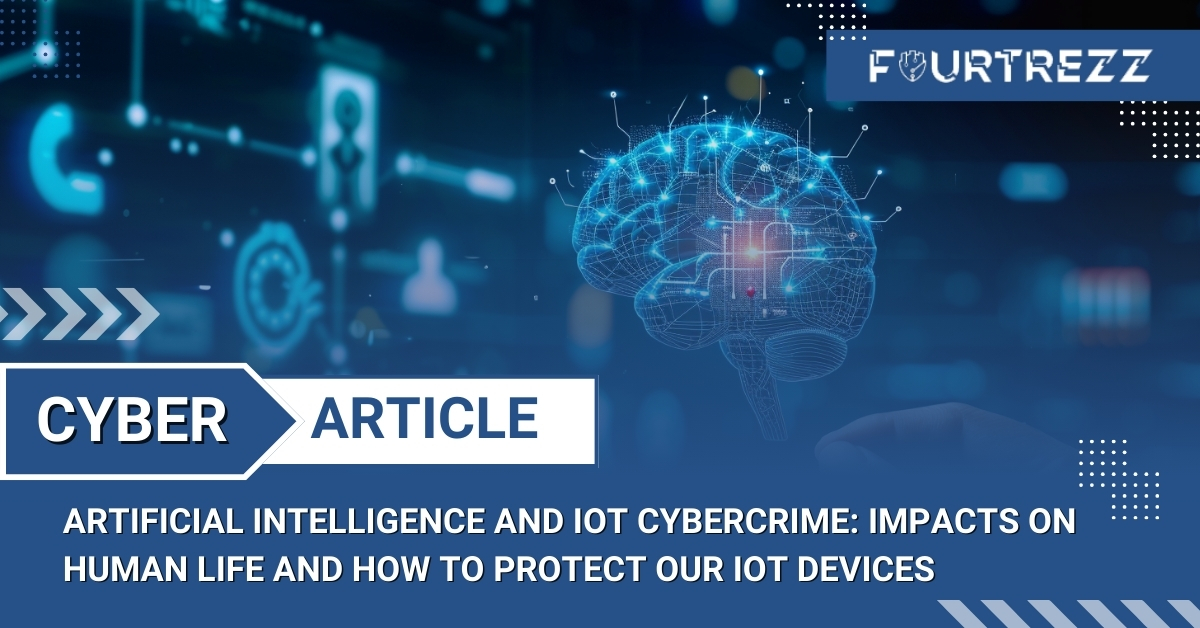Artificial Intelligence, commonly abbreviated as AI, is a technology that enables machines to perform tasks that usually require human intelligence. Examples of AI applications include chatbots, games, and virtual assistants like Siri and Alexa. AI technology development utilizes Machine Learning techniques, allowing machines to learn from data without needing specific programming.
IoT Cybercrime, on the other hand, refers to cybercrimes targeting Internet of Things (IoT) devices. IoT devices are internet-connected and capable of communicating with other devices. Examples of IoT devices include security cameras, smart home devices, and smartwatches. Cyber attacks on IoT devices can involve damaging the devices or hijacking stored data.
Understanding these definitions is fundamental to comprehending Artificial Intelligence and IoT Cybercrime. It’s important to grasp both concepts to fully understand the dangers of IoT Cybercrime and the benefits of Artificial Intelligence.

Impact of Artificial Intelligence on Our Lives
Artificial Intelligence (AI) has influenced many aspects of our current lives. This introduction discusses both the positive and negative impacts of AI technology on human life.
Positive Impacts of AI on Human Life
- Ease in Daily Life: AI technology can be used to make life easier and more efficient. For example, virtual assistants can help with household chores, booking flights or hotels, and assisting in work tasks.
- Advancement in Health: AI is used in health research to assist in disease diagnosis, drug development, and medical technology advancements. Examples include telemedicine and new drug development.
- Progress in Industry: AI technology is employed in various industries like automotive, manufacturing, and transportation to enhance efficiency and productivity. Examples include robot-controlled car production and predictive algorithms used in transportation.
Negative Impacts of AI on Human Life
- Replacement of Human Jobs: With the increasing sophistication of AI technology, some human jobs may be replaced by machines, impacting unemployment rates and the economy.
- Privacy: In the use of AI technology, personal and sensitive data may be used without consent or knowledge, leading to privacy breaches and unwanted surveillance.
- Security: AI technology can be utilized for cybercrime and attacking security and privacy systems.
Therefore, when considering the impact of AI technology, it is important to consider both sides, the positive and the negative. AI technology can offer significant benefits to human life but also poses risks and issues if not used wisely.
Threats of IoT Cybercrime to Our IoT Devices
IoT Cybercrime refers to cyber attacks targeting the Internet of Things (IoT) devices we use daily. This introduction discusses the types of cyber attacks on IoT devices and their impact on our personal data security.
Types of Cyber Attacks on IoT Devices
- Malware: Malware is a malicious program designed to take over IoT devices and access stored information. It can spread through Wi-Fi or Bluetooth networks.
- Denial-of-Service (DoS) Attacks: DoS attacks aim to overwhelm a system with requests, causing it to slow down or become non-functional.
- Man-in-the-Middle (MitM) Attacks: MitM attacks occur when an attacker positions themselves in the communication between an IoT device and a server, accessing and altering the data sent between them.
Impact of IoT Cybercrime on Our Personal Data Security
- Personal Data Hijacking: Attackers can take over IoT devices and access personal data such as passwords, credit card numbers, and other personal information.
- Unauthorized Surveillance: Attackers can access and spy on our IoT devices without permission, monitoring our activities or eavesdropping on our conversations and transactions.
- Fraud and Theft: IoT Cybercrime can also be used for fraud and theft, such as accessing our home security systems or taking over vehicle security systems.
We must always be vigilant against the threat of IoT Cybercrime and take preventive measures like enabling IoT device security, using strong passwords, and regularly updating IoT devices. By taking appropriate precautions, we can help protect our personal data from cyber attacks.
How to Protect IoT Devices from Cyber Attacks
The Internet of Things (IoT) has brought many benefits to our lives, but it also opens up vulnerabilities to cyber attacks that can jeopardize the security of our personal data. Therefore, it’s crucial for us to take steps to protect our IoT devices from cyber attacks.
Here are some tips to safeguard IoT devices against cyber threats:
- Choose Secure and Reliable IoT Devices: Before purchasing IoT devices, research the brand and product reputation. Choose brands and products known for high security levels and robust security systems to protect your devices.
- Change Default Passwords: Many IoT devices come with easily guessable default passwords, like “admin” or “password”. Ensure to change these default passwords to strong, hard-to-guess ones.
- Regularly Update IoT Device Firmware: Outdated firmware can leave gaps for cyber attacks. Regularly update your IoT device firmware and follow the manufacturer’s instructions.
- Disable Unnecessary Features: Many IoT devices have unnecessary features that can increase the risk of cyber attacks. Turn off features you don’t need, like Bluetooth or Wi-Fi, when not in use.
- Use a Secure Network: Ensure your Wi-Fi network is encrypted and protected with a strong password. Avoid using unsecured public networks to access your IoT devices.
By taking these steps to protect your IoT devices from cyber attacks, you can ensure the security of your personal data and avoid potential identity theft or financial losses due to cyber attacks.
Conclusion
In today’s digital era, the use of IoT devices is increasingly prevalent in society. However, the widespread use of IoT devices also brings more complex cyber attack threats. Therefore, it is extremely important to protect our IoT devices from cyber attacks.
In this regard, AI can play a role in protecting IoT devices from cyber attacks. AI can be used to detect cyber attacks on IoT devices and automatically respond to counteract these attacks.
However, AI can also pose a threat to IoT device security if not properly regulated. Therefore, the development of safe and reliable AI technology is necessary to maintain IoT device security.
In this context, choosing secure and reliable IoT devices is crucial. Additionally, regularly updating IoT device firmware is necessary to address emerging security vulnerabilities.
By maintaining the security of our IoT devices, we can also protect the personal data stored within them. As users, we must be aware of the importance of protecting our IoT devices from cyber attacks.
AI and IoT Cybercrime are interrelated. The use of AI can help protect IoT devices from cyber attacks, but it can also become a threat if not properly managed. Therefore, as users, we need to be conscious of securing our IoT devices and developing safe and reliable AI technology.










